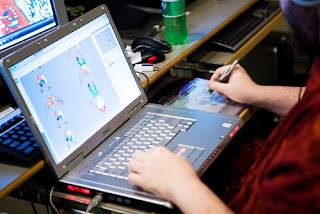 |
| Student designing a game at the Game Design Campus at Vancouver Film School. Web Source: Flickr |
Players: How many players are in the game? Can players have relationships? Can new players come in and out of the game?
Objectives: What are the players trying to achieve? What is the goal of this game?
'Capture/destroy. Eliminate all of your opponent’s pieces from the game. Chess and Stratego are some well-known examples where you must eliminate the opposing forces to win.
Territorial control. The focus is not necessarily on destroying the opponent, but on controlling certain areas of the board. RISK andDiplomacy are examples.
Collection. The card game Rummy and its variants involve collecting sets of cards to win. Bohnanza involves collecting sets of beans. Many platformer video games (such as the Spyro series) included levels where you had to collect a certain number of objects scattered throughout the level.
Solve. The board game Clue (or Cluedo, depending on where you live) is an example of a game where the objective is to solve a puzzle. Lesser-known (but more interesting) examples are Castle of Magic and Sleuth.
Chase/race/escape. Generally, anything where you are running towards or away from something; the playground game Tag and the video gameSuper Mario Bros. are examples.
Spatial alignment. A number of games involve positioning of elements as an objective, including the non-digital games Tic-Tac-Toe and Pente and the video game Tetris.
Build. The opposite of “destroy” — your goal is to advance your character(s) or build your resources to a certain point. The Sims has strong elements of this; the board game Settlers of Catan is an example also.
Negation of another goal. Some games end when one player performs an act that is forbiden by the rules, and that player loses. Examples are the physical dexterity games Twister and Jenga.'~ Atomic Elements of Games: Game Design Concepts
Rules: Setup (things you do once at the beginning of the game),
Progression of play (what happens during the game)
Resolution (what conditions cause the game to end, and how is an outcome determined based on the game state).
Resources and Resource Management: Anything that the player can make use of within the game in order to help them win for example: Time, Money, Lives and Weapons etc.
Game State: Everything in the game together.
Game Info: How much information is available to the player? How much of the game state is available to the player?
Sequencing: Taking turns, real-time etc.
Player Interaction: How do player's interact with one another?
'Direct conflict (“I attack you”)
Negotiation (“If you support me to enter the Black Sea, I’ll help you get into Cairo next turn”)
Trading (“I’ll give you a Wood in exchange for your Wheat”)
Information sharing'~ Atomic Elements of Games: Game Design Concepts
Theme(Narrative, Back Story): What is the whole story behind the player doing this? Why are they here? Set the scene.
Game as Systems: A System is: a combination of things or parts that form a complex whole.) Elements within the game that come together to form the general game system.
In Formal Abstract Design Tools by Doug Church, Church explores how there isn't a set language assigned to describe game design elements, when there should be. "A precise vocabulary would improve our understanding of and facility with game creation." Instead of "I don't think this game is fun" we should be using language we have learned to describe why the game isn't good in a technical and professional manner. "We could dissect a game into its components, and attempt to understand how these parts balance and fit together."
Church goes on to evaluate Mario 64. I learned many design components that are used in this game that I could bring into my own game design. I learned that it is a good idea to put the first goal (star in this case of Mario 64) the furthest away from the players original position so they have the opportunity to explore the game world they just entered. Limited controls used in the game make it easier for the player to decide on what they will do when it comes to an obstacle because there are limited options. This makes the user experience enjoyable and not extremely challenging or impossible.
Comments
Post a Comment